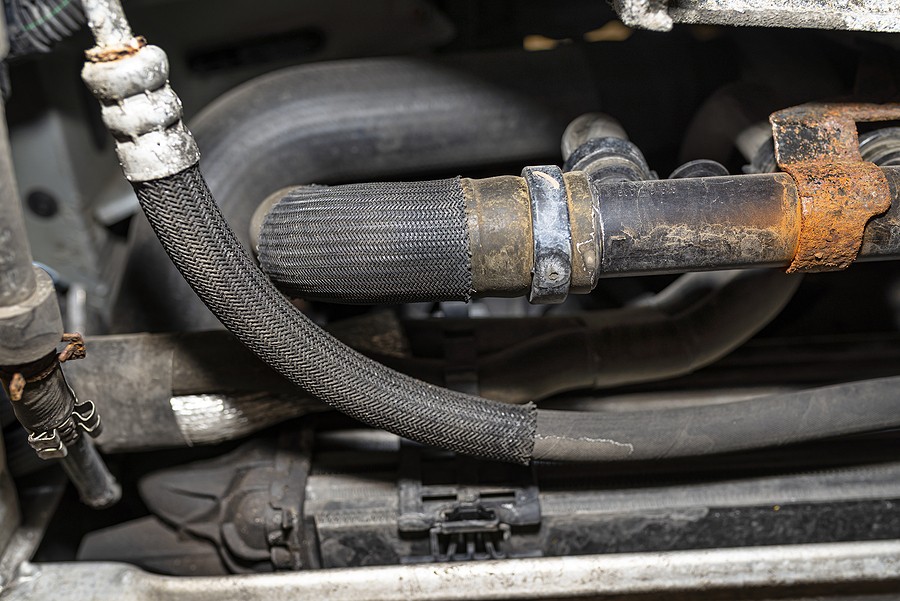
Drain the engine coolant when it has cooled. The upper radiator hose carries hot coolant from the thermostat housing on the engine to the radiator inlet.
If so remember to cut carefully so you dont damage the radiator.
How to repair radiator hose. How to Repair a Radiator Hose. Before you can replace the radiator hose you need to drain your cooling system. Make sure the car is turned off and that.
Remove the Radiator Hose. If you have a radiator hose leak fixing it is usually pretty simple. Most auto parts stores carry hoses specific to your vehicle meaning they are constructed with the right length shape and diameter to fit perfectly on your car.
Once youve got the new hose you can start the replacement process by draining your vehicles coolant. Begin by identifying the leaking radiator hose that needs to be replaced. Do this by running the car to operating.
Drain the engine coolant when it has cooled. Open the petcock on the lower end of the radiator and drain it into a. Loosen the clamps on the leaking radiator hose.
How to Fix a Cracked Radiator Hose Step 1. Open the hood and examine the radiator hoses. Determine the source of the leak.
For example the clamps that. Turn off the engine and let it cool down for 30 minutes. Tighten the radiator clamps with a screwdriver.
If the clamp has been. Radiator Hose Repair with Duct Tape. Tear off a two or three-inch piece of duct tape and place it over the hole in the radiator hose.
Starting at the center just over the hole press the tape firmly in place. Tear a piece of duct tape long enough to wrap around the hose about 4 to 6 inches long. Stick the tape on the hose making sure to cover the hole.
Step 5 Reinforce the taped section of the hose by wrapping another piece of tape on either side of the first piece. How to Repair a Broken Hose Connection on a Plastic Radiator Step 1. Disconnect the hoses from the radiator after allowing the vehicle to cool down.
Unscrew the metal rings. After allowing the coolant to flow from the radiator remove the radiator from the vehicle. The removal of the.
Learn to spot the signs of a radiator leak and how to seal a leak. This is our step-by-step guide on how to fix a radiator leak at home or on the road. Signs of a Radiator Leak.
First its important to check for signs of a leaking radiator. A small leak may be difficult to notice at first but a major leak should be easy to identify. If the cap has a pressure-release flap thats released your engine may have only overheated but if the cap is intact and you can see a leak in the heater hose youll be able to fix it.
Once the engine is cool remove the radiator cap. Put the cap back on after the fix. The upper radiator hose carries hot coolant from the thermostat housing on the engine to the radiator inlet.
After the coolant passes through the radiator and sheds excess heat the coolant exits the bottom of the radiator into the lower radiator hose bringing the cooled fluid back to the engine. Check the radiator hose and clamps for signs of wetness. If its coming from the radiator youll need to replace it.
If the leak is coming from a hose or hose clamp you will simply need to replace the hose. One great way to tackle this project is with a hose repair kit which has nylon some kits are steel or aluminum couplers and clamps. In order to build a custom radiator hose you need a coupler and some elbows.
You can use a new radiator hose and simply cut the bend you need as well. Use a flat head screwdriver to remove the hose clamps on both ends of the hose. You may have to use a utility knife to remove the hose completely.
If so remember to cut carefully so you dont damage the radiator. Put the hose clamps on to the new radiator hose and put it in proper position. Tighten the hose clamps.
Open the hood after you park the vehicle to allow the heat to dissipate unimpeded. Be prepared to wait for a few hours for your engine to cool enough to work on. With a hot water system water must be drained from the radiator.
Turn down the thermostat. Attach a hose to the boilers drain valve and run the hose to a floor drain. Open the valve to drain the system.
Starting at the top floor of your house open the bleeder valves of all radiators.